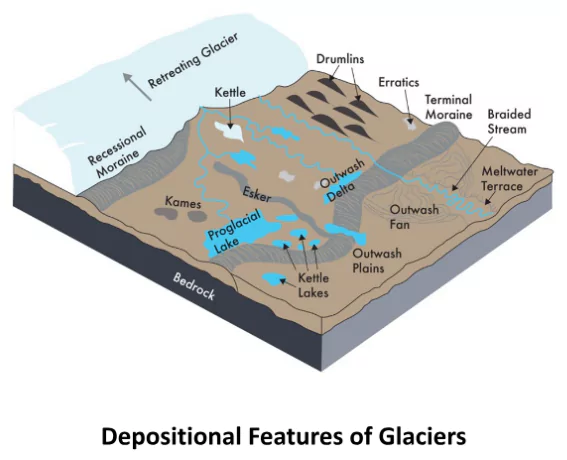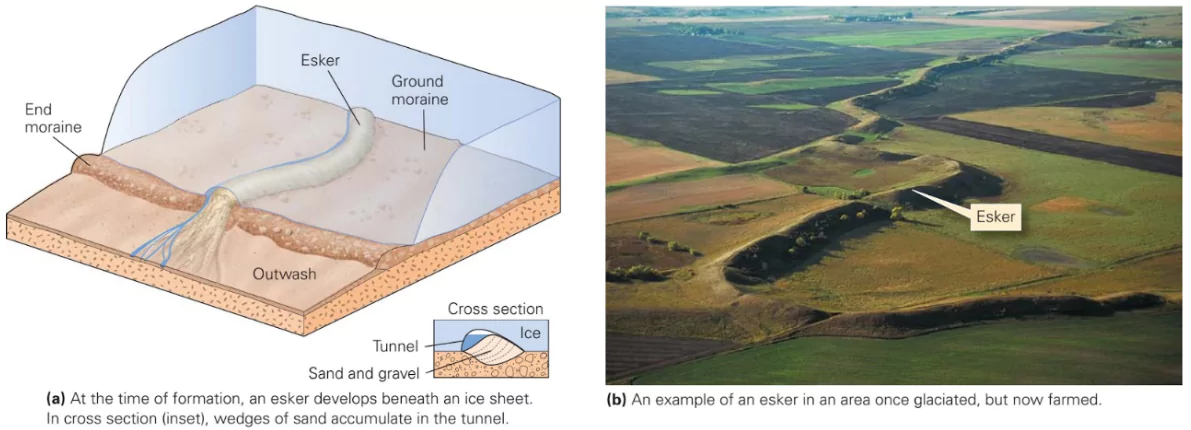Introduction
Glaciers, vast sheets of ice that slowly slide over the land, have a profound impact on shaping the landscape. They cover expansive areas, such as plains adjacent to mountains, and flow down valleys between mountain ranges. Driven by gravity, glaciers move gradually, altering the terrain as they advance. Through their movement, glaciers deposit sediment and sculpt distinctive landforms, contributing to the diverse and captivating features known as glacial depositional landforms.
Depositional Landforms Created by Glacial

- Glacial Till: Glacial till is unsorted coarse and fine debris left behind as glaciers melt; It mainly consists of angular to sub-angular rocks.
- Outwash Deposits: Some amount of rock debris small enough to be carried by meltwater streams is washed down and deposited. Such glacio-fluvial deposits are called outwash deposits.
- Moraines: Moraines are long ridges of glacial till deposits; named differently on the basis of locations they found:
- Moraines: Terminal MorainesThese are found at the end (toe) of glaciers,
- Lateral moraines form along the sides parallel to glacial valleys. These moraines may join to create horse-shoe-shaped ridges.
- Valley glaciers, retreating rapidly, often leave irregular sheets of so called ground moraines on their valley floors.
- Medial moraines are found in the center of glacial valleys.

- Eskers: These are sinuous ridges formed by water flowing beneath melting glaciers.
- When glaciers melt, water gathers beneath them and carries coarse materials.
- As the glacier vanishes, these materials form ridges called eskers.
- Outwash Plains: The plains at the foot of the glacial mountains are covered with glacio-fluvial deposits in the form of broad flat alluvial fans which join to form outwash plains of gravel, silt, sand, and clay.
- Drumlins: These are smooth, oval-shaped hills made of rocks and dirt.
- These hills have two ends. One end called the stoss end, is flatter and steeper, while the other end is called the tail.
- They are typically the result of glacial deposition and can occur in clusters, creating a “basket of eggs” topography.
Enroll now for UPSC Online Course
- Kettle Lake: This is a depression in the outwash plain left by the melting of masses of stagnant ice.
- Large kettles may contain numerous low mounds called hummocks.
- Fjords: Fjords are deep, narrow, and elongated inlets of the sea, typically flanked by steep cliffs or slopes.
- It is formed through a combination of glacial, geological, and hydrological processes.
- It is characterised by U-shaped glacial valleys submerged in the sea.
Conclusion
Glacial depositional landforms exhibit remarkable diversity, sculpted by the movement and retreat of glaciers. From the rugged ridges of the Moraines to the sinuous contours of eskers, each feature tells a story of dynamic geological processes. These formations, including drumlins, kettle lakes, and fjords, attest to the profound impact of glaciers on shaping Earth’s landscapes.
![]() April 27, 2024
April 27, 2024
![]() 6489
6489
![]() 0
0

